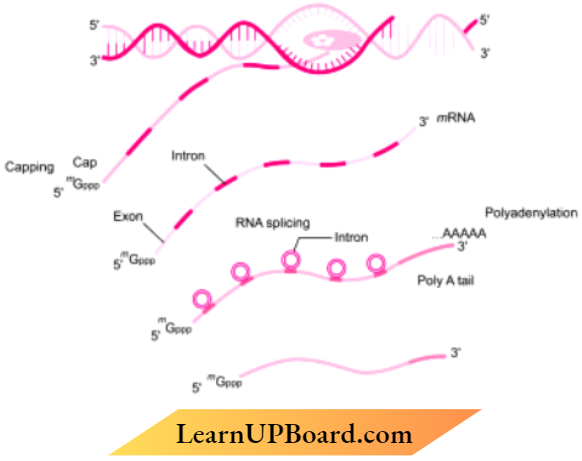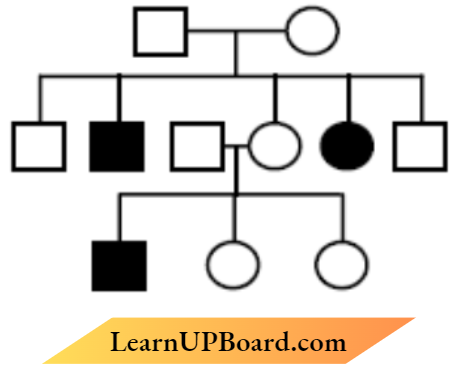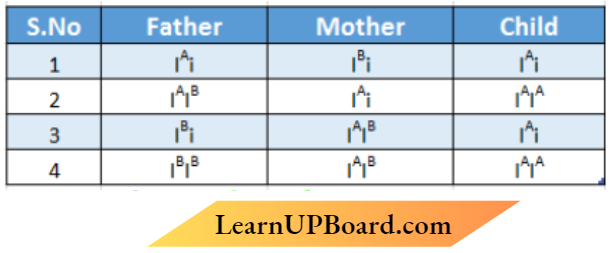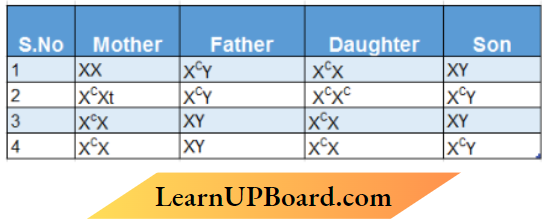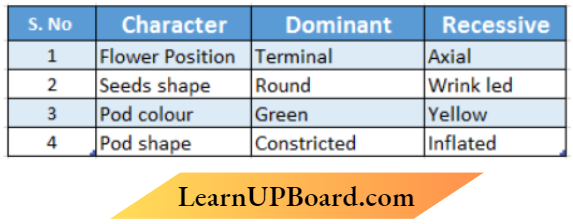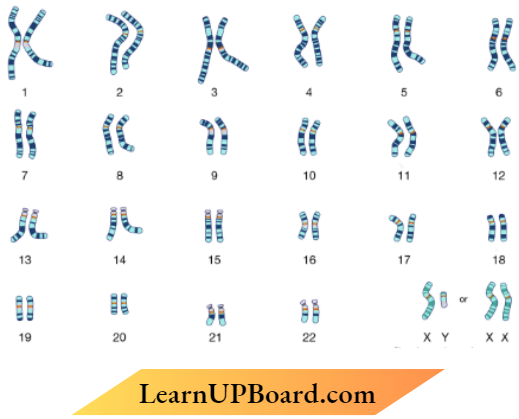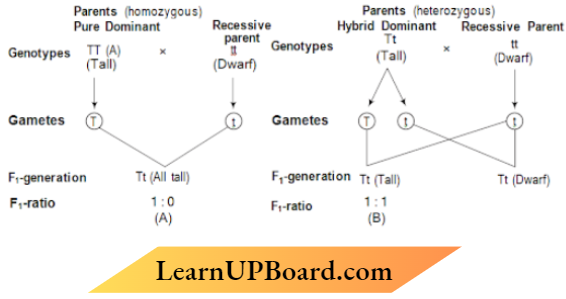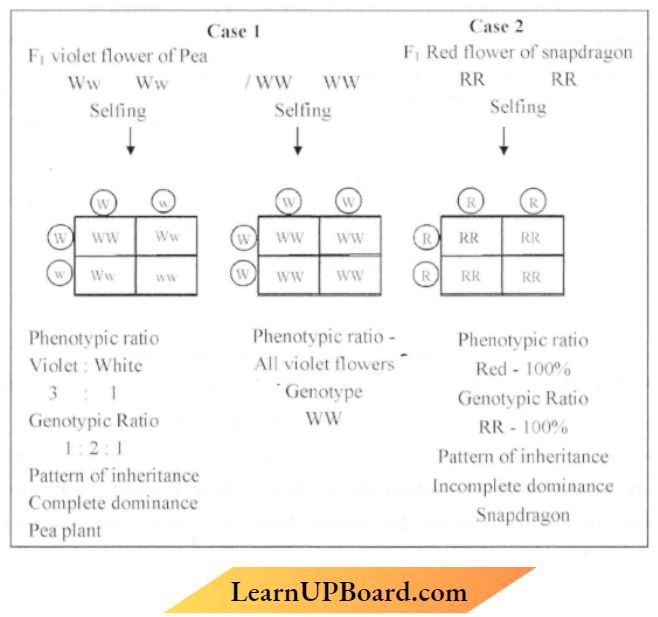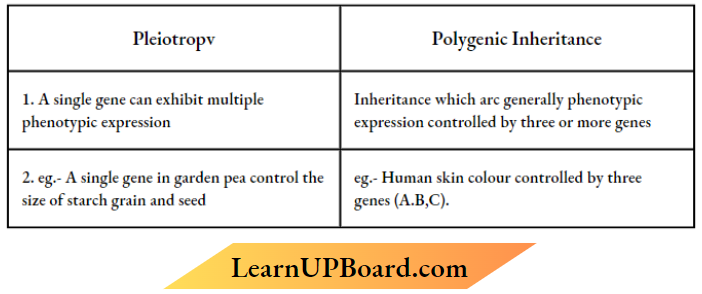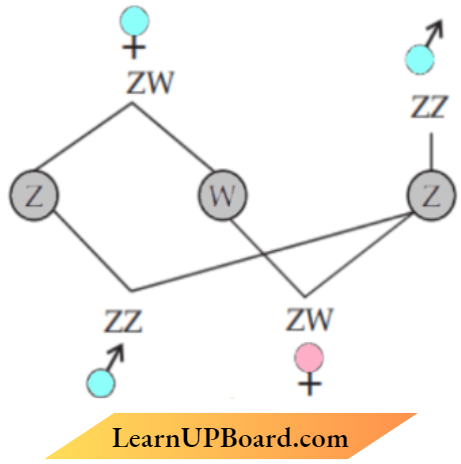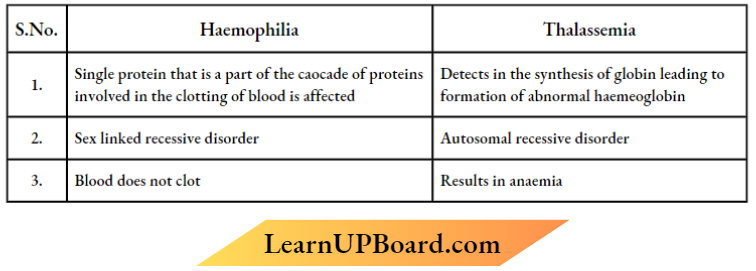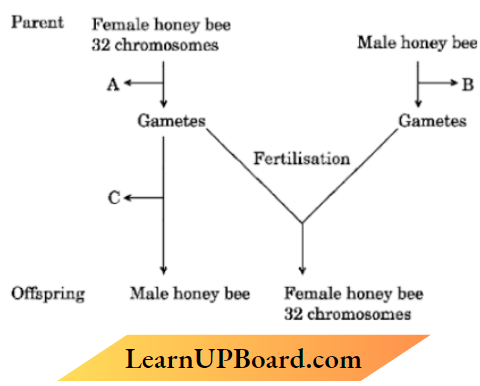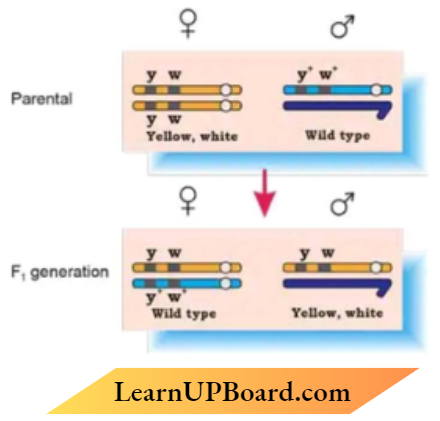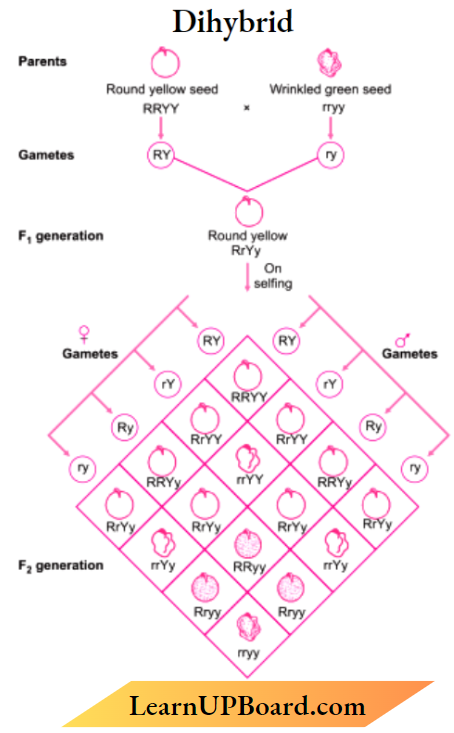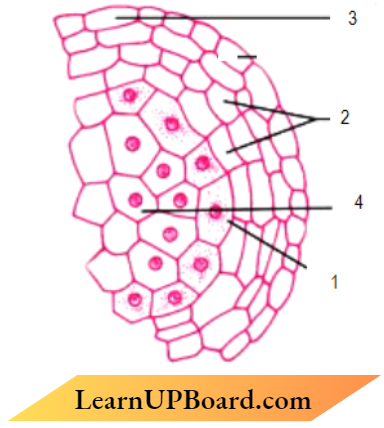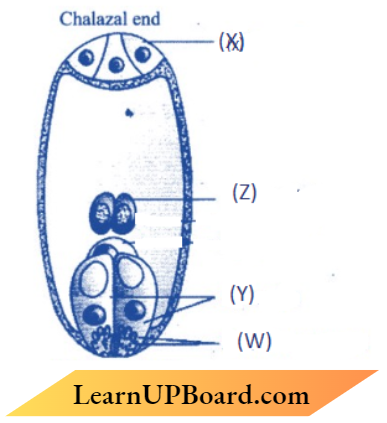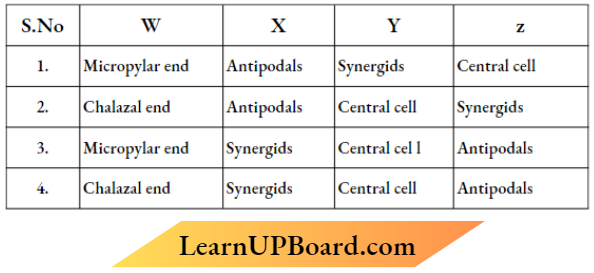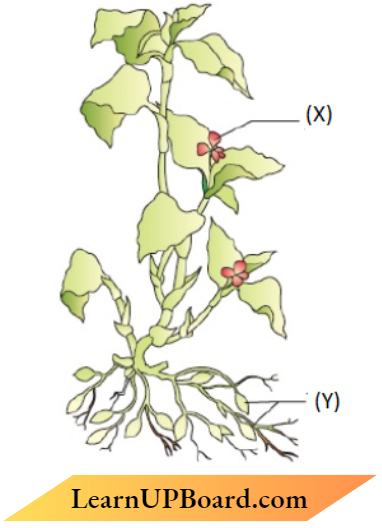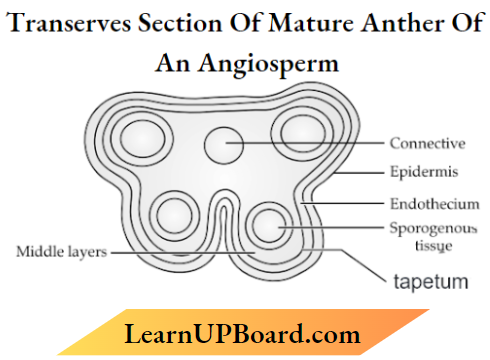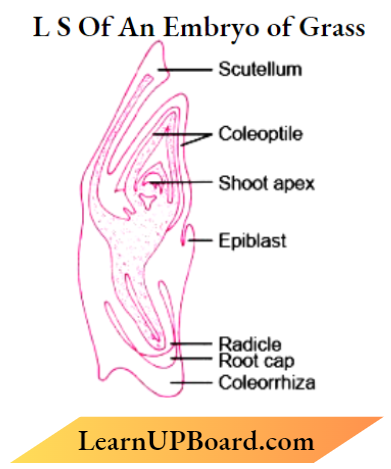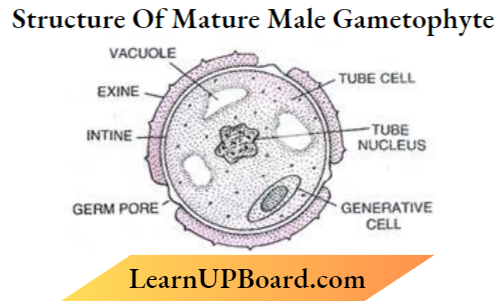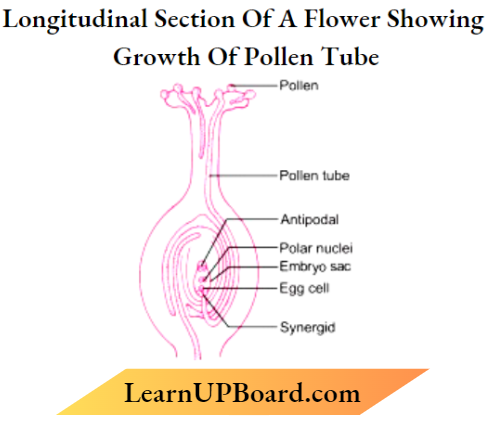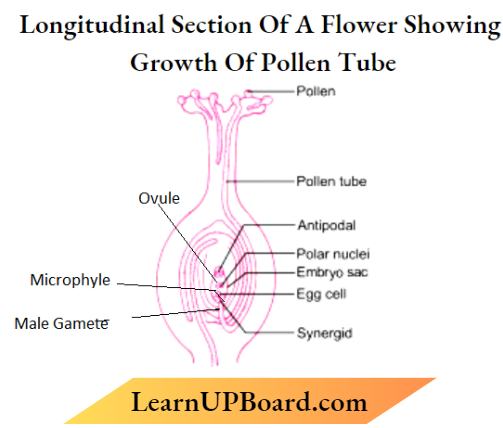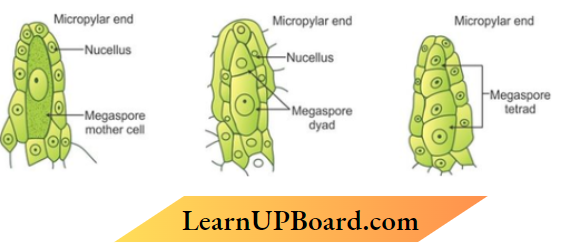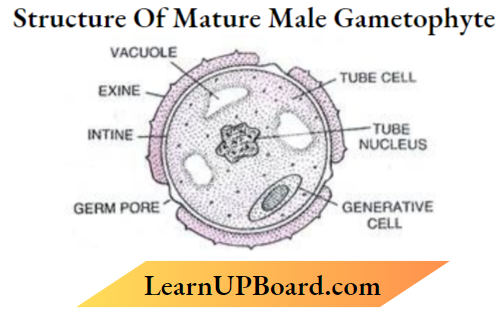Important Questions for Class 12 Biology Chapter 5 – Molecular Basis of Inheritance Very Short Question And Answers
Question 1. Given the low are the observations drawn in HGP. Select the options that show the correct observations.
- The human genome contains 3164.7 billion base pairs.
- The average gene consists of 3000 bases.
- Less than 2% of the genome codes for proteins.
- Chromosome one has the most genes ( 2698 )
- 1 and 2
- 2 and 3
- 3 and 4
- 1 and 3
Answer: 2. 2 and 3
Question 2. The phosphodiester linkage in the formation of a nucleotide involves the bonding between
- Phosphate group and OH of 3’C of a nucleoside
- Phosphate group and OH of 5’C of a nucleoside
- Phosphate group and H of 3’C of a nucleoside
- Phosphate group and H of 5’C of a nucleoside
Answer: 2. Phosphate group and OH of 5’C of a nucleoside.
” principles of inheritance and variation”
Question 3. The switching ‘on’ and ‘off of the lac operon in prokaryotes is regulated by
- Glucose
- Galactose
- Lactose
- Fructose
Answer: 3. Lactose.
Question 4.For ‘in-vitro’ DNA replication, which one of the following substrates needs to be added along with the necessary enzymes the DNA template, and specific conditions?
- Ribonucleotide triphosphate
- Deoxyribonucleoside triphosphate
- Deoxyribonucleotide triphosphate
- Ribonucleoside triphosphate
Answer: 2. Deoxy r i bo nu Pelosi triphosphate
Read and Learn More Important Questions for Class 12 Biology Chapter Wise
Question 5. Which one of the following factors will associate transiently with RNA polymerase to terminate transcription in prokaryotes?
- Sigma factor
- Rho factor
- Delta factor
- Theta factor
Answer: 2. Rho factor
Question 6.Choose the correct pair of codons with their corresponding amino acids from the following list:
- UAG: Glycine
- AUG: Arginine
- UUU: Phenylalanine
- UGA: Methionine
Answer: 3. UUU: Phenylalanine
Question 7. During the elongation process of translation, the peptide bond formation between amino acids is catalyzed
- Ribosomal RNA
- Protein in the small subunit of the ribosome
- Protein to the large subunit of the ribosome
- Transfer RNA
Answer: 1 . Ribosomal RNA
Question 8. A region of the coding strand of DNA has the following nucleotide sequence: 5-TGCGCCA – 3’ The sequence of bases on niRNA transcribed by this DNA strand would be:
- 3′ – ACGCGGT – 5′
- 5′ – ACGCGGT – 3′
- 5′ – UGCGCCA – 3’
- 3′ – UGCGCCA – 5′
Answer: 3. 5′ – UGCGCCA – 3′
Question 9. A DNA molecule is 160 base pairs long. It has 20# adenine. How many cytosine bases are present in this DNA molecule?
- 192
- 96
- 64
- 42
Answer: 2. 96
” principles of inheritance and variation class 12″
Question 10. A template strand in a bacterial DNA has the following base sequence:
5′ – TTTAACGAGG – 3′
- 5′ – AAATTGCTCC- 3′
- 3′ -AATTGCTCC-5′
- 3′ – AAAUUGCUCC – 3’
- 5’ – CCUCGUUAAA – 3′
Answer: 3. 5′ – CCUCGUUAAA – 3′
Question 11. tRNA has an that has bases complementary to the codon. Its actual structure is a compact molecule which looks like. Select the option that has the correct choices for the two ‘blanks’
- Amino acid acceptor end, clover-leaf
- Anticodon loop, clover-leaf
- Amino acid acceptor end, inverted L
- Anticodon loop, inverted L
Answer: 3. Anticodon loop, inverted L
Question 12. Which type of RNA is correctly paired with its function?
- Small nuclear RNA – Processes rRNA
- Transfer RNA: attaches to amino acid
- Ribosomal RNA: involved in transcription
- Micro RNA: involved in translation
Answer: 2. Transfer RNA: attaches to an amino acid.
Question 13. The figure given below has labeling (1), (2), and (3), which two labeling in the given figure are components of a nucleosome? Select the correct option.

- 1 – H1 histone, 2 – DNA
- 1 – DNA, 2 – Histone Detainer
- 2 – DNA, 3 – HI Histone
- 2 – Histone octamer, 3 – DNA
Answer: 4. 2 – Histone octamer, 3 – DNA
“inheritance class 12 “
Question 14. Which one of the following diagrams is a correct depiction of a Polynucleotide chain To DNA?

Answer: 2
Question 15. In molecular biology who proposed that genetic information flows in one direction?
- Hargobind Khoraim
- Francis Crick
- Watson mid-Crick
- Marshall Nirenhcrg
Answer: 2. Francis Crick
Watson and Crick proposed that genetic information flows in one direction.
Question 16. Meseison and Stahl carried out centrifugation in CsC12 density gradient to separate :
- DNA from RN A
- DNA from protein
- The normal DNA from rN-DNA
- DNA from tRNA
Answer: 3. The normal DNA from rN-DNA
Question 17. Write the dual purpose served by Deoxyribonudeoside triphosphates in polymerization.
Answer:
Acts as a substrate towards the reaction and provides energy to the poh memorization ie energy source (from the initial two phosphates’)
Question 18. Name one amino add, which is coded by only one codon.
Answer:
Methionine Tryptophan
Question 19. Write the conclusion Griffith arrived at the end of his experiment with Streptococcus pneumoniae.
Answer:
He concluded that 11 ml of the R .sbaiu bacteria had somehow been transformed h\ the local ‘killed S strain bacteria.
Important Questions for Class 12 Biology Chapter 5 – Molecular Basis of Inheritance Short Question And Answers
Question 1. Draw a labeled schematic representation of the Central Dogma of Molecular Biology as proposed by Francis Crick.
Answer:
Francis Crick proposed the Central dogma in molecular biology, which states that the genetic information flows from DNA → RNA → Protein
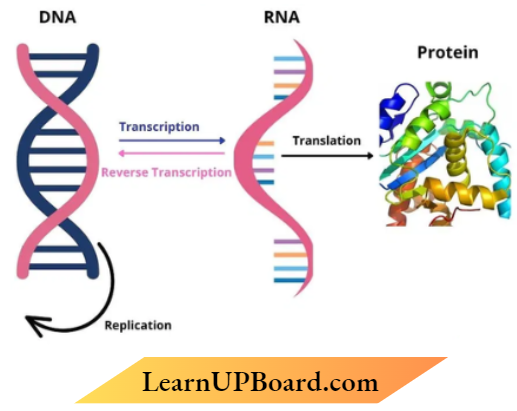
Question 2. State four salient observations drawn from the Human Genome Project.
Answer:
- Some of the salient observations drawn from the human genome project are as follows :
- The human genome contains 3164.7 million bp.
- The average gene consists of 3000 bases, but sizes vary greatly, with the largest known human gene being dystrophin at 2.4 million bases.
- The total number of genes is estimated at 30,000-much lower than previous estimates of 80.000 to 1.40.000 genes. Almost: all (99.9 percent) nucleotide bases are the same in all people.
The functions are unknown for over 50 percent of the discovered genes.
“genetics questions and answers pdf “
Question 3. Given below is one of the strands of a DNA segment :
![]()
1. Write its complementary strand.
Answer:
![]() (Polarity, Nucleotide sequence)
(Polarity, Nucleotide sequence)
2. Write a possible RNA strand that can be transcribed from the above DNA molecule formed.
Answer:
 (Polarity, Nucleotide sequence)
(Polarity, Nucleotide sequence)
Question 4. Draw a schematic diagram of a transcription unit with the polarity of the DNA strands and label the coding strand, template strand, and terminator.
Answer:
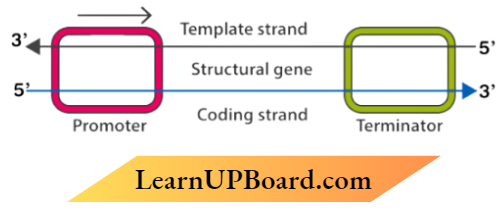
Question 5. A segment of a DNA molecule comprises 546 nucleotides. How many cytosine nucleotides would be present in it if the number of adenine nucleotides is 96?
Answer:
⇒\(\begin{aligned}
& \text { Given total Nucleotides }=546 \\
& \mathrm{G}+\mathrm{C}=546-192=354 \text { because } \mathrm{G}=\mathrm{C} \text { so } \mathrm{C}=354 / 2, \\
& \text { Cytosine }=177
\end{aligned}\)
6. Although a prokaryotic cell has no defined nucleus, DNA is not scattered throughout the cell ‘Explain.
Answer:
DNA is negatively charged & positively charged proteins and can hold it in places and large loops (in a region termed as nucleoid)
Question 7. Differentiate between the genetic codes given below :
- Unambiguous and Universal
- Degenerate and Initiator
Answer:
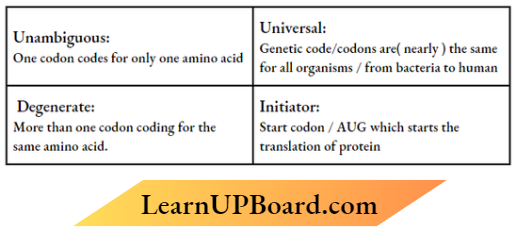
Question 8.
1. Draw a polynucleotide chain (four nucleotides long) of DNA having four variable
nitrogenous bases.
Answer:
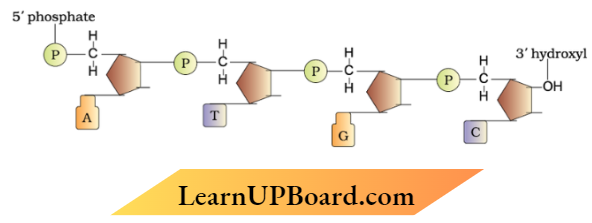
“principles of inheritance and variation short notes “
2. Draw a neat labeled diagram of the nucleosome. Name the basic amino acid residues present mainly in the nucleosome.
Answer:
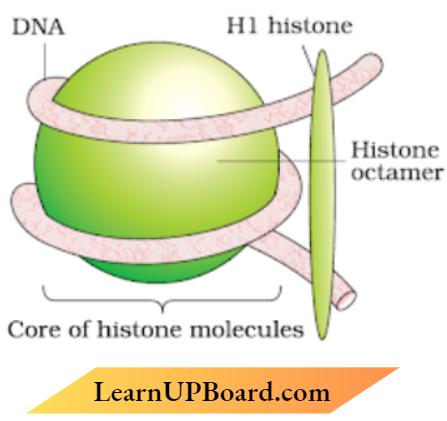
Amino Acid: Lysine and Arginine
Question 9.
1. Explain the events occurring in a ‘Replicating Fork” during the replication of DNA.
Answer:
DNA-dependent DNA polymerase catalyzes the polymerization, of deoxynucleotides Or deoxyribonucleotide triphosphates.
- The polymerization takes only in one direction 5’→3‘, on one strand (the template with polarity 3′ .5) the replication is continuous, while on the other (the template with polarity 5″ →3′) it is discontinuous, – the discontinuous)’ synthesized fragments are later joined by the enzyme DNA Haase.
2. Name the different types of RNA polymerases in a eukaryotic cell. Write their roles in transcription.
Or
3. Name the three RNA polymerases found in eukaryotic cells and mention their functions.
Answer:
RNA polymerase 1 →transcribes rRNAs(28S or 18S or 5.8S).
RNA polymerase 2→ transcribes precursor of mRNA or hnRNA or heterogenous nuclear RNA
RNA polymerase 3 → transcribes tRNA or 5srRNA or snRNAs or small nuclear RNAs
Question 10. Explain the mechanism of translation that occurs in the ribosomes in a prokaryote.
Answer:
- Charging of tRNA Or aminoacylation of tRNA. the small subunit of ribosome binds to RNA
(5′ end), for initiation, the ribosome binds to the mRNA at the start codon (AUG) that is recognized only by initiator tRNA - In the elongation phase, an amino acid with tRNA sequentially binds to the appropriate codon on mRNA(forming complimentary base pairs with tRNA anticodon),
- Ribosome moves from codoil to codon along the mRNA and amino acids are added one by one in the two sites of the large subunit joined by a peptide bond.
- Termination occurs when a release factor binds to the stop codon and releases the complete po 1 ypepti de.
Question 11. Explain the role of regulatory genes in a lac operon. Why is the regulation of lac operon called negative regulation?
Answer:
- Regulatory gene-gene codes for the repressor of the lac operon, the repressor protein (synthesized by the I gene, binds to the operator site of the operon, and prevents the RNA polymerase from transcribing the operon
- The repressor of the lac operon is synthesized constitutively all 1 the time, and thus the operon is in a switched-off position generally, it is switched on only when lactose is present in the culture medium of the E.coli when the operon gets ‘switched on’
Question 12.
1. Expand VNTR and describe its role in DNA fingerprinting.
Answer:
VNTR -Variable Number of Tandem Repeat(s) -used as a probe (because of its high degree of polymorphism)
2. List any two applications of DNA fingerprinting techniques.
Answer:
Forensic science or criminal investigation (any point related to forensic science (determining population and genetic diversity paternity testing or maternity testing or study of evolutionary biology.
13. Why is the DNA molecule a better hereditary material than the RNA molecule?
Answer:
The DNA molecule is a better hereditary material.
- It is more stable (due to the presence of thymine and not uracil as in RNA).
- Less reactive than RNA (as RNA has 2″ – Oil making it more reactive).
- Being less reactive, DNA is not easily degradable (RNA being more reactive is easily degradable).
- The rate of mutation is slow (The rate of mutation in RNA is faster)
Question 14. Explain the post-transcriptional modifications the hn-RNA undergoes in eukaryotic cells.
Answer:
- Splicing → lustrous are removed and exons are joined
- Capping → Methyl guanosine triphosphate Or map is added to the 5’ end of hnRNA
- Tailing → Polyadenylate residues are added to 3’etui in a template-independent manner
Question 15.
1. List the two methodologies involved in the human genome project. Mention how they were used.
Answer:
Expressed Sequence Tags, Identifying all the genes that are expressed as RNA Sequence Annotation, sequencing the whole set of genome coding or noncoding sequences, and later assigning different regions with functions.
2. Expand ’YAC and mention what was it used for.
Answer:
Yeast Artificial Chromosomes used as cloning vectors (cloning/amplification)
Question 16. Identify, A, B, C, D, E, and F In the table given below :
Answer:
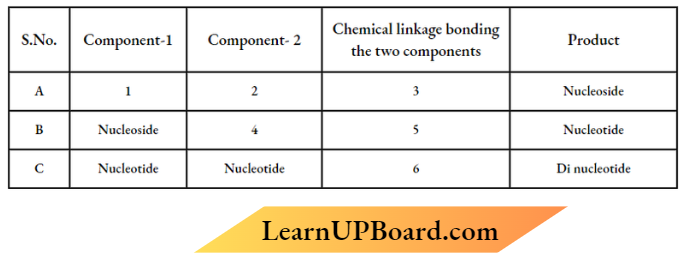
- Nitrogenous base
- OH of PC pentose sugar
- N-glycosidic linkage
- phosphate group
- phosphodiester linkage
- 3′-5’ phosphodiester linkage
Important Questions for Class 12 Biology Chapter 5 – Molecular Basis of Inheritance Long Question And Answers
Question 1.
1. How did Matthew Meselson and Franklin Stall? experimentally prove that DNA replication
Answer:
Matthew Meselson and Franklin Stahl performed the following experiment in 1958 : (They grew E.coli in a medium containing NiliCl ( ‘.NHs the heavy isotope of nitrogen) as the only nitrogen source for many generations. The result was that is N was incorporated into newly synthesized DNA (as well as other nitrogen-containing compounds). This heavy DNA molecule could be distinguished from the normal DNA by centrifugation in a cesium chloride (CsCl) density gradient (Please note that 15N is not a radioactive isotope, and it can be separated from 14N only based on densities).
2. The use of heavy isotope of nitrogen by Meselson and Stahl demonstrated a semi-conservative mode of replication of a DNA molecule.” Explain how they arrived at this conclusion.
Answer:
Then they transferred the cells into a medium with normal “14NH4Cl and took samples at various definite time intervals as the cells multiplied, and extracted the DNA that remained as double-stranded helices. The various samples were separated independently by oil CsCl gradients to measure the densities of DNA.
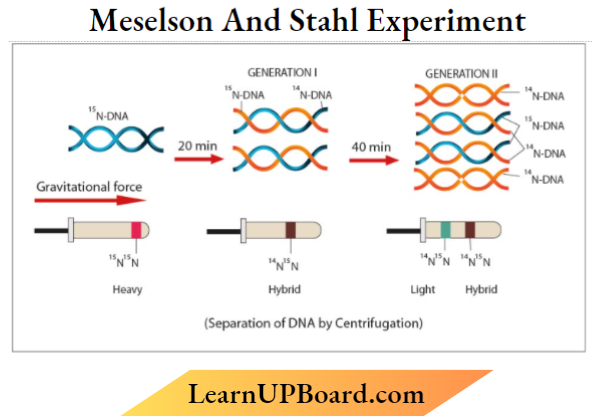
Question 2.
1. Name and describe the technique which is an important tool of forensic science.
Answer:
The technique is DMA fingerprinting DNA profiling DNA typing Or DNA test.
- It is a technique to identify a person based on his/her DNA specificity.
- This technique was invented by Sir Alec Jeffery (1984).
- In India, DNA Fingerprinting has been started by Dr. V.K. Kashyap & Dr. Lai Ji Singh.
- DNA of humans is almost (99.9%) the same but a very small amount (0.1 that differs from person to person,
- The human genome has 3.3 x 10 bp
- 0.1 % different = 3.3 x 1 bp
- These differences are mainly due to – Repetitive DNA sequences.
- These repetitive DNA are separated from bulk genomic DNA as different peaks during density gradient centrifugation.
- Differences in DNA sequences.
- Arises due to mutations.
- Allelic sequence variation has traditionally been described as a DNA polymorphism if more than one variant (allele) at a locus occurs in a human population with a frequency greater than 0.01.
- In simple terms, if an inheritable mutation is observed in a population at high frequency, it is referred to as DNA polymorphism.
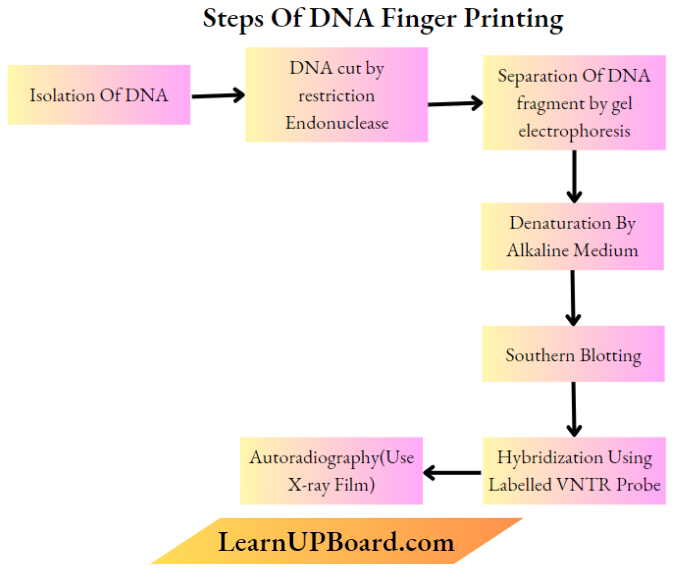
2. Mention any two applications of this technique other than its use in forensic studies.
Answer:
To determine the population and genetic diversities of the population.
Question 3. Describe the experiment carried out by Mershey and Chase. Write the conclusion they arrived at.
Or
1. Hershey and Chase carried out their experiment in three steps: infection, blending, and centrifugation. Explain each step.
2. Write the conclusion and interpretation of the result they obtained.
Answer:
They grew viruses on a medium containing radioactive phosphorus r P) and some on radioactive sulfur ( “Si radioactive D.NA contained in viruses grown on radioactive phosphorus, the radioactive protein contained in virus grown in radioactive sulfur. Radioactive phages were allowed to attach to E.rolibacteria, the virus coats were removed from bacteria by agitating in a blender, and the virus particles were separated from the bacteria on centrifugation. Bacteria infected with viruses containing radioactive DNA were radioactive, whereas bacterial cells infected with viruses containing radioactive protein did not show radioactivity.
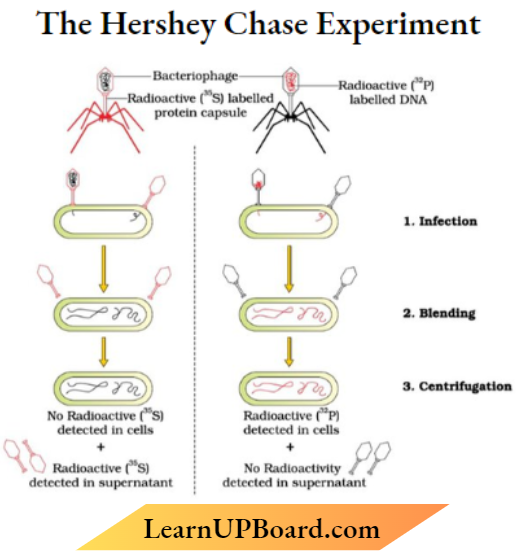
Conclusion – DNA is therefore the genetic material that is passed from virus to bacteria.
Question 4. List the different components of a Lac Operon. Explain the role of these components, when the operon is in an ‘open state’.
Answer:
Components: Regulatory gene/the T gene (inhibitor), and three structural genes i.e. z, y, and a Repressor, which is synthesized (all-the-time -constitutively from the I gene, is inactivated by interaction with the inducer (lactose or also lactose), this allows RNA polymerase access to die promoter, turning on the transcription of these three genes in the lac operon, which in turn produces enzymes responsible for digestion of lactose (ß – galactosidase break lactose to glucose and galactose)
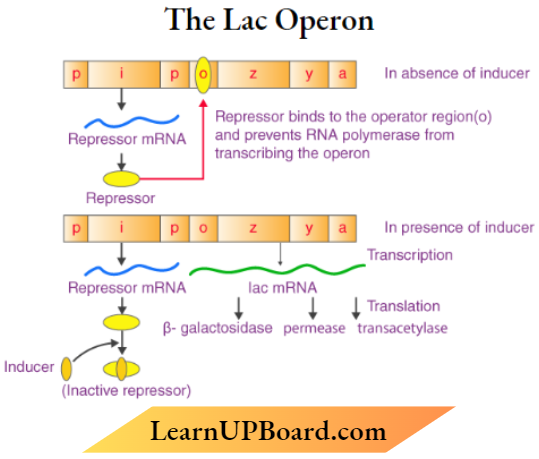
Question 5. Write the five important goals of the Human Genome Project (HGP).
Answer:
Goals of HGP
- Identify all the approximately 20.000-25.000 genes in human DNA.
- Determine the sequences of the 3 billion chemical base pairs that make up human DNA:
- Store this information in databases
- Improve tools for data analysis
- Transfer related technologies to other sectors, such as industries:
- Address the ethical, legal, and social issues (El. SI) that may arise front the project.
Question 6. Compare the processes of DN A replication and transcription in prokaryotes.
Answer:
Similarities:
Both the processes involve –
- Unwinding of the helix and separating the two DNA strands
- Breaking the hydrogen bonds between the bases/pairs
- Follow the complementary base pair rule
- Polymerization occurs in a 5′ → 3′ direction
- linking Polvmeriaction of nucleotides
Dissimilarities:
- DNA replication Transcription
- DNA nucleotides added are RNA nucleotides added are ATP, GTP, CTP, TTP ATP, GTP, CTP. UTP
- Deoxyribose sugar is the part of Ribose sugar is the part of nucleotide Adenine pairs with Thymine Adenine with Uracil
- Both strands copied Only one strand copied.
- Resulting in two DNA molecules resulting in the formation of an RNA molecule (Any other correct dissimilarity)
Question 7.
1. Explain Griffith’s ‘transforming principle’ experiment.
Answer:
When Streptococcus pneumoniae (pneumococcus) bacteria are grown on a culture plate produce smooth shiny colonies (S) because the S strain bacteria have a mucus (polysaccharide) coat, Mice infected with the S strain(x indent) die from pneumonia infection while others produce rough colonies (R), but mice infected with the R strain do not develop pneumonia. Griffith observed that heat-killed S strain bacteria when injected into mice did not kill them, When he injected a mixture of heat-killed S and live R bacteria, the mice died. Moreover, he recovered living S bacteria from the dead mice.
2. In the above experiment, ‘’heat which killed one type of bacteria, did not destroy the properties of genetic material.’” Justify
Answer:
The two DN A strands get separated by heating and come together, when appropriate conditions are provided heat does not destroy the genetic properties.
Question 8.
1. State the ‘Central dogma’ as proposed by Francis (“rick. Are there any exceptions to it? Support your answer with a reason and an example.
Answer:
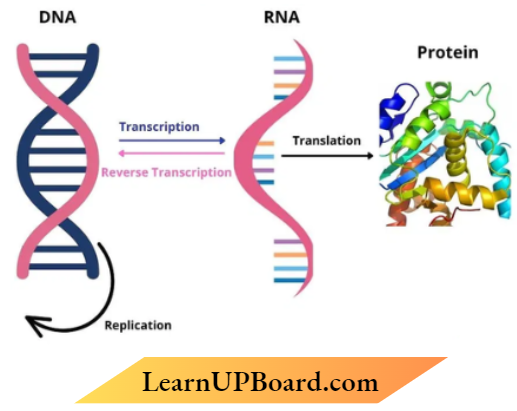
Yes, in some viruses flow of information is in reverse direction/reverse transcription e.g. Retrovirus/HIV.
2. Explain how the biochemical characterization (nature) of the ‘Transforming Principle’ was determined, which was not defined in Griffith’s experiments.
Answer:
Protein DNA and RNA were purified from heat-killed S strain/smooth Streptococci! s/Diploco( cits pneumoniae
- Protein + Protease → transformation secured (R cell to S type)
- RNA + RNA use → transformation occurred (R cell to S type)
- DNA + DNA use → transformation inhibited
Hence, DNA alone is the transforming material
Question 9.
1. Why does DNA replication occur in small replication forks and not in its entire
length?
Answer:
DNA being very long, requires high energy for opening along its entire length
2. Why is DNA replication continuous and discontinuous in a replication fork?
Answer:
DNA-dependent DNA polymerase catalyzes polymerization only in one direction, i.e.Two strands of DNA are anti-parallel and have opposite polarity
3. State the importance of the origin of replication in a replication fork.
Answer:
The site where replication originates
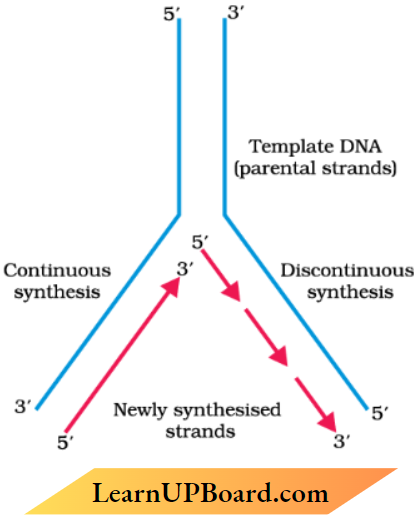
4. What is an operon? Explain the functioning of the lac option when in an open state.
Answer:
The arrangement where a (Polycistronic) structural gene is regulated by a common promoter and regulatory genes.
Lactose acts as an inducer and binds with repressor protein, RNA polymerase freely moves over the structural genes, and transcribes lac miRNA, which in turn produces enzymes-transacetylase. permease, ß-galactosidase (by lac z), is responsible for the digestion of lactose.
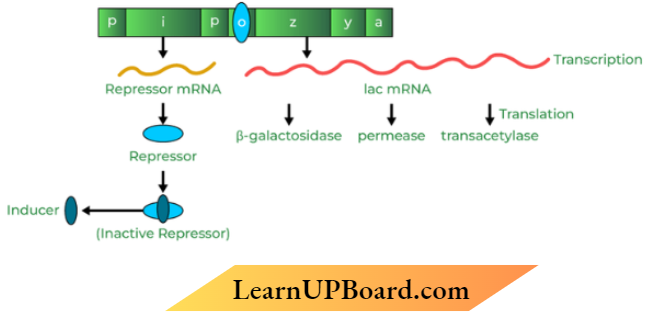
Question 10.
1. Describe the structure and function of a t-RNA molecule. Why is it referred to as an adapter molecule?
Answer:
Clover-leaf shaped/inverted L-shaped molecules have an anti-codon loop with bases complementary to specific codons. has an amino acid acceptor end. It reads the code on one hand and binds with the specific amino acid on the other hand.
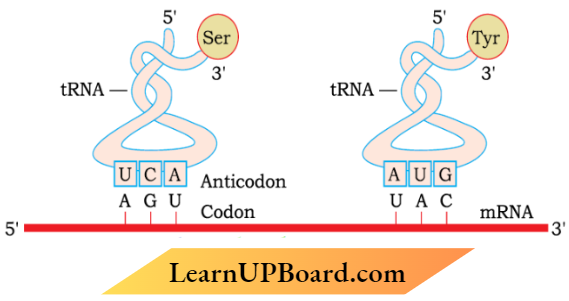
2. Explain the process of splicing of hn-RNA in a eukaryotic cell.
Answer:
Introns are removed, and exons are joined in a definite order called splicing.
